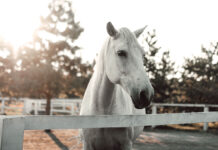Spring is on the way, and so are all the births. Cattle, horses, sheep, goats and some pigs.
I wanted to go over the process for cattle. First, we should already have our cows and heifers vaccinated properly and in good body condition.
We like to see a body condition score of 6 for all cows and heifers when they calve in. Hopefully, they will milk off to a BCS of 5 and then gain back to a 6 by calving time next year. This is ideal.
As cattle get close, we should see some evidence of milk in the bag increasing. Sometimes, we don’t necessarily see it till the day of calving. But a lot of times, we do see it. Within the last 24 to 48 hours, we will see a loosening of the ligament between the tail head and the pin bones. Normally, almost all cows will be giving birth within 24 to 48 hours of this ligament loosening up. You can also see some looseness to the vulva area, but this is not as reliable as the ligament.
Calving first starts with the water breaking and a few contractions. From the time the water breaks, you have approximately four hours for a heifer to start producing a calf on the ground but only three hours for a cow to start producing a calf on the ground. But once you see feet or parts of the calf sticking out of the vulva, then forget that first rule of thumb, and then I only give that heifer or cow 30 to 45 minutes to deliver the calf to the ground. Otherwise, she needs assistance, whether it be by you or you decide to call a veterinarian.
Once the calf is on the ground, we still have the third stage of labor to go through, which is delivering the placenta. I have seen this take three or four days, and normally, I give single birth three days, and then twins, I will give them four days before I ever step in and assist with the delivery of the placenta. A lot of people now only start giving them antibiotics and let them deliver the placenta totally on their own. This is the new thought from a lot of bigwigs. Most of the time, we are looking at the possibility of a mineral deficiency such as selenium and or vitamin A or vitamin E contributing to hanging on of the placenta.
Now, once we have a calf on the ground, we really need that calf nursing colostrum as soon as possible. For the first 18 to 24 hours, this calf needs to get at least 1 gallon of colostrum. Without this type of consumption of colostrum, this calf will be susceptible to almost all bugs in the environment.
I have checked these calves after two days of age and found them to be totally deficient in immunity or partially deficient in immunity. These immune-deficient cares will not live, and only part of the partially deficient calves will live. For the ones that do live that are only partially deficient, we will probably treat them several times until they are 1 to 2 months of age for either scours and/or pneumonia. It has also been correlated that we will have better health all the way to the knocking box with these animals that receive adequate colostrum at birth.
Dr. Tim E. O’Neill, DVM, owns Country Veterinary Service in Farmington, Ark. To contact Tim go to ozarksfn.com and click on ‘Contact Us.’






